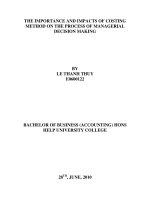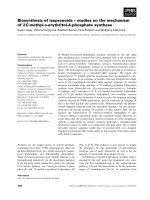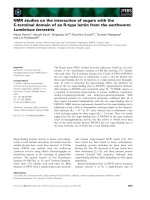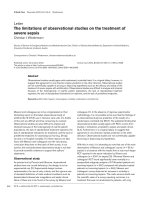Studies on the molecular and cellular mechanisms underlying the process of learning and memory formation
Bạn đang xem bản rút gọn của tài liệu. Xem và tải ngay bản đầy đủ của tài liệu tại đây (269.53 KB, 14 trang )
Acknowledgements
Pursuit of a Ph.D degree is an important time in my life and an exciting journey into
discovery. I would like to first and foremost thank my supervisors Professor Sheu FwuShan for his guidance, encouragement and help. Prof. Sheu has been exceedingly
generous with his time and advice all the 6 years and taught me molecular and cellular
neuroscience. I also would like to thank my co-supervisor Professor Lim Tit Meng for his
support in the most tough 2-year extension to complete my PhD works in DBS.
My heartfelt thanks also go to Professor Aryeh Routtenberg in Northwestern
University for his precious suggestions in all the three projects of my PhD work. I would
thank Professor Frank Watt in Center for Ion Beam Applications (CIBA), Dept of Physics,
NUS for his advice in the project of quantitative analysis of zinc in rat hippocampal
mossy fibers by nuclear microscopy; Dr. Chuang Kai-Hsiang in Singapore Bioimaging
Consortium (SBIC) for his professional knowledge in the collaboration of the project
using manganese-enhanced magnetic resonance imaging (MEMRI). Thanks also go to Dr.
Sashi Kesavapany in Dept of Biochemistry, NUS for the generous providing the
transgenetic mice from his lab.
I am also grateful to Dr. Ren Minqin in Center for Ion Beam Applications (CIBA),
Dept of Physics, NUS for her invaluable suggestions and help in my research. I could not
complete the work without her knowledge and emotional support.
I would also acknowledge the financial support of National University of Singapore
and spiritual support from my family through this special and important period of my life.
i
Table of Contents
Acknowledgements………………………………………………………………………...i
Table of Contents………………………………………………………………………….ii
Abstract..…………………………………………………………………………………..x
List of Tables…………………………………………………………………………….xii
List of Figures…………………………………………………………………………..xii
Publications……………………………………………………………………………..xiv
Part I. Investigations on Learning-Induced Remodeling of Hippocampal Mossy Fibers:
The
Role
of
Presynaptic
Structural
Plasticity
in
Long-Term
Memory ………………………...........................................................................................1
Chapter 1
Introduction………………………………………….……………………...1
1.1 Introduction of hippocampal mossy fibers……............................................................1
1.1.1 Anatomy of the hippocampal mossy fibers……………………………….....1
1.1.1.1 Introduction of the hippocampus……………………………….....1
1.1.1.2 Introduction of the mossy fibers…………………………………..4
1.1.2 Histology of Mossy fiber pathways………………………………………....5
1.1.3 Anatomic plasticity of the mossy fibers……………………..........................8
1.2 Plasticity of the mossy fibers……………….................................................................9
1.2.1 Short-term plasticity…..................................................................................10
1.2.2 Mechanisms of short-term plasticity…….....................................................11
1.2.2.1 A1 adenosine receptors………………….......................................12
ii
1.2.2.2 Metabotropic glutamate receptors…………………......................12
1.2.2.3 Kainate receptors…………………………………………...........13
1.2.2.4 Intrinsic conductances…………………………............................15
1.2.3 Long-term plasticity --- long-term potentiation………................................15
1.2.3.1 NMDA receptor independent……………….................................16
1.2.3.2 Postsynaptic calcium elevation………………..............................17
1.2.3.3 Cyclic AMP …………………………………………...................17
1.2.3.4 Downstream targets of PKA and PKC …......................................18
1.2.4 Long-term depression…………………………………………...................18
1.3 Mossy fibers in learning and memory……………………………………….............19
1.3.1 Role of mossy fibers plasticity in learning and memory..............................19
1.3.2 Species and strains difference in mossy fibers…….....................................21
1.4 Significance of studies………………………………………….................................23
1.4.1 Missing gap…………………………………………...................................23
1.4.2 Objectives………………………………………….....................................25
Chapter 2 Materials and methods……………………………………....……..................27
2.1. Animal model ………………………………………….............................................27
2.2. Neuroanatomical methods ………………………………………….........................27
2.2.1 Brain tissue preparation…………………………………………................28
2.2.1.1 Preparation of unfixed fresh-frozen brain tissue………................28
2.2.1.1.1 Materials………………………………………….........28
2.2.1.1.2 Protocol…………...........................................................28
iii
2.2.1.2 Perfusion fixation…………………...............................................29
2.2.1.2.1 Materials…………………………………….................29
2.2.1.2.2 Protocol………………………………...........................30
2.2.2 Cryostat sectioning of frozen brain tissue……………………………......................31
2.2.2.1 Materials…………………………………………............................................32
2.2.2.2 Protocol………………………………………..............................32
2.2.3 Histological study……………………………….........................................33
2.2.3.1 Nissl stain ............................................…......................................33
2.2.3.2 Timm’s stain...............………………………………....................34
2.2.3.2.1 Solution preparation........................................................34
2.2.3.2.2 Protocol...........................................................................37
2.2.3.3 Immunohistochemistry……………………………......................37
2.2.3.3.1 Protocol for avidin-biotin complex (ABC) method........38
2.3. Behavioral studies – Morris water maze...…………..................................................39
Chapter 3 In vivo analysis of hippocampal mossy fiber remodeling by manganeseenhanced magnetic resonance imaging (MEMRI) ….......................................................40
3.1 Introduction...…………...............................................................................................40
3.1.1 Remodeling of the mossy fibers...…………................................................40
3.1.2 Histological method of detection...…………...............................................40
3.1.3 Introduction of MEMRI...………….............................................................42
3.1.4 Objectives...…………..................................................................................44
3.2 Materials and methods...…………..............................................................................45
iv
3.2.1 Subjects...…………......................................................................................45
3.2.2 Hidden platform water maze task...…………..............................................46
3.2.2.1 Apparatus...…………....................................................................46
3.2.2.2 Procedures...…………...................................................................46
3.2.3 MEMRI experiments...………….................................................................47
3.2.3.1 Animal preparation...…………......................................................47
3.2.3.2 MRI acquisition...…………..........................................................47
3.2.3.3 Data processing...…………...........................................................48
3.2.3.3.1 Alignment of 3D MRI Volumes...…………...................48
3.2.3.3.2 Manual Segmentation of the Mossy Fibers...……….....51
3.2.3.3.3 Quantification of Mossy Fiber Area...............................52
3.2.3.3.4 Statistical Analysis...………….......................................52
3.2.4 Timm’s staining...…………..........................................................................52
3.2.4.1 Timm’s staining…..........................................................................52
3.2.4.2 Timm’s analysis….........................................................................53
3.2.5 Statistical analysis...…………......................................................................55
3.3 Results...………….......................................................................................................55
3.3.1 MEMRI allows imaging hippocampal mossy fiber in vivo and
longitudinally.........................................................................................................55
3.3.2 LH rats performed better than the Wistar rats in the hidden platform
overtraining water maze task.................................................................................57
3.3.3 Overtraining-induced expansion of mossy fiber terminal fields was observed
in Wistar rats not in Lister-Hooded rats.................................................................61
v
3.3.4 MEMRI analysis of learning-induced remodeling of the hippocampal mossy
fibers in vivo...........................................................................................................68
3.4 Discussion....................................................................................................................77
Chapter 4 Quantitative analysis of zinc in rat hippocampal mossy fibers by nuclear
microscopy.........................................................................................................................81
4.1 Introduction.................................................................................................................81
4.1.1 Biological functions of Zn............................................................................81
4.1.2 Zn in the brain...............................................................................................81
4.1.3 Rationale ......................................................................................................83
4.1.4 Aim................................................................................................................85
4.2 Materials and methods.................................................................................................85
4.2.1 Animals and tissue preparations....................................................................85
4.2.2 Histology analysis.........................................................................................87
4.2.2.1 Timm’s staining..............................................................................87
4.2.2.2 Nissl staining..................................................................................88
4.2.3 Mapping and quantifying Zn: Nuclear microscopy......................................88
4.2.3.1 Introduction of nuclear microscopy...............................................88
4.2.3.2 Mapping and quantifying Zn.........................................................90
4.3 Results..........................................................................................................................91
4.3.1 Elemental mapping of hippocampus.............................................................91
4.3.2 Zn profile by line scan in CA3......................................................................93
4.3.3 Quantitative analysis of Zn...........................................................................98
vi
4.4 Discussion.................................................................................................................102
PART II. The Role of Cyclin-Dependent Kinase 5 (Cdk5) in Consolidation of Fear
Memory............................................................................................................................106
Chapter 5 Hippocampus dependent memory is impaired in heterozygous cyclindependent kinase 5 knockout mice (Cdk5+/-)...................................................................106
5.1 Introduction...............................................................................................................106
5.1.1 Introduction of fear conditioning................................................................106
5.1.2 Introduction of Cdk5...................................................................................108
5.1.2.1 Cdk5 in the development of the nervous system.........................109
5.1.2.2 Cdk5 in presynapse......................................................................110
5.1.2.3 Cdk5 in postsynapse.....................................................................110
5.1.3 Pharmacological studies on Cdk5 in learning and memory........................112
5.1.4 Rational and objective.................................................................................113
5.2 Materials and methods...............................................................................................113
5.2.1 Animals.......................................................................................................114
5.2.2 Apparatus....................................................................................................114
5.2.3 Experiment procedures...............................................................................115
5.2.3.1 Fear conditioning training............................................................115
5.2.3.2 Short-term contextual memory and cued memory test................115
5.2.3.3 Retention and extinction of long-term contextual memory and cued
memory....................................................................................................116
5.2.4 Genotyping analysis....................................................................................116
vii
5.2.5 Western blot................................................................................................118
5.2.6 Immunohistochemistry................................................................................119
5.2.7 Optical density measurements....................................................................120
5.2.8 Statistical analysis.......................................................................................120
5.3 Results.......................................................................................................................120
5.3.1 Reduction of Cdk5 protein in the Cdk5+/- mice..........................................120
5.3.2 Training of contextual fear conditioning was not affected in Cdk5+/mice......................................................................................................................125
5.3.3 Both short-term and long-term contextual memory was impaired in Cdk5+/mice......................................................................................................................125
5.3.4 Cdk5+/- mice showed no impairments in cued fear memory.......................131
5.3.5 Reduction of Cdk5 facilitates contextual extinction but not cued
extinction..............................................................................................................131
5.4 Discussions................................................................................................................132
PART III. Summary and Future works............................................................................136
Chapter 6 Summary and contributions............................................................................136
6.1 In vivo analysis of hippocampal mossy fiber remodeling by manganese-enhanced
magnetic resonance imaging (MEMRI)...........................................................................136
6.2 Quantitative analysis of zinc in rat hippocampal mossy fibers by nuclear
microscopy.......................................................................................................................137
6.3 Hippocampus dependent memory is impaired in heterozygous cyclin-dependent
kinase 5 knockout mice (Cdk5+/-)...................................................................................138
viii
Chapter 7 Future works....................................................................................................140
7.1 In vivo analysis of hippocampal mossy fiber remodeling by manganese-enhanced
magnetic resonance imaging (MEMRI)...........................................................................140
7.2 Quantitative analysis of zinc in rat hippocampal mossy fibers by nuclear
microscopy.......................................................................................................................140
7.3 Hippocampus dependent memory is impaired in heterozygous cyclin-dependent
kinase 5 knockout mice (Cdk5+/-)...................................................................................141
References………………………………………………………………………………142
ix
Abstract
There are two parts of work which have been done in this thesis to investigate the
underlying mechanisms of learning process and long-term memory formation. In part I,
two projects have been focused on the hippocampal mossy fibers (MFs), aiming at
elucidating the role of presynaptic structural plasticity in long-term memory. In the first
study, the MRI technique, in which manganese-enhanced magnetic resonance imaging
(MEMRI) is employed, has been implemented to detect the learning-induced MFs
remodeling during the spatial memory formation in vivo. Using a quantitative analysis of
a series of sections in the rostral dorsal hippocampus, MEMRI showed an increase in the
high contrast area CA3a’ area in trained Wistar rats. Besides, the hypothesis that
remodeling pattern of the MFs is strain-dependent has been confirmed by comparison
between two strains of rats: Wistar and Lister-Hooded (LH) rats. In contrast to Wistar, no
obvious remodeling of MFs was found in trained LH. So far as we know, this is the first
study to employ MEMRI to visualize the structural redistribution of the hippocampal
MFs that is induced by spatial learning.
In the second study, the laminar-specific Zn levels in the synapses from MFs to CA3
region of the hippocampus have been mapped and quantified in µg/g dry weight level as
well as molar concentration in wet weight level, using an alternative approach nuclear
microscopy. This is the first reported data showing the Zn concentration in the three
different strata (stratum lucidum SL, stratum pyramidale SO, and stratum oriens SP) of
hippocampal CA3 region (Zhang et al., 2011). As the axon fibers projecting to CA3
pyramidal neurons, the MFs play a critical role in the hippocampal-related learning and
x
long-term memory procedures. Investigations on the learning-induced presynaptic
plasticity might shed lights on the complicated mechanisms underlying the hippocampalrecruited long-term memory.
In part II, a mutant mouse model, heterozygous knockout mouse (Cdk5+/-) has been
employed to evaluate the critical role of cyclin-dependent kinase 5 (Cdk5) in fear
learning and memory. The data here has shown that deficiencies in both short-term (3
hours) and long-term (24 hours) contextual fear memory were observed as the result of
reduced Cdk5 protein in Cdk5+/- mice. In addition, Cdk5+/- facilitates the extinction of
contextual fear conditioning. This is the first study to use heterozygous Cdk5 knockout
mice to test the hypothesis that reducing levels of Cdk5 would impair performance in
contextual fear conditioning. This data is complementary to previous pharmacological
studies. The mutant model Cdk5+/- employed in the study makes possible for further
investigations on the different molecular mechanisms involved in amygdala-related cuedor tone-dependent fear conditioning.
xi
List of Tables
Table 4.1. Average concentrations and standard errors of Fe Cu and Zn in different layers
and background levels, based on seven sections from seven rats....................................100
List of Figures
Figure 1.1 Basic anatomy of the hippocampus formation .......................………………...3
Figure 1.2 Hippocampal mossy fiber pathways of a Wistar rat ......................………........6
Figure 3.1. Alignment of 3D MRI to bregma in atlas....................………………………49
Figure 3.2. Images for the slices chosen for segmentation at -2.52 mm, -2.64 mm,
-2.76 mm, -2.88 mm, -3.00 mm, -3.12 mm, -3.24 mm, -3.36 mm, -3.48 mm to
bregma....................................................................................................…………………50
Figure 3.3. Segmentation of MRI images...............................................................……...51
Figure 3.4. Coronal MEMRI of rat brain at 20 h, 2 days, and 8 days post intravenous
infusion of MnCl2 at the dose of 80 mg/kg..................…………………………………..57
Figure 3.5. Lister-Hooded rats (LH) show better performance than Wistar rats in the
hidden platform overtraining water maze task ..........................................................……59
Figure 3.6. Overtraining-induced expansion of mossy fiber terminal fields was observed
in Wistar rats .......................................................................……………………………..64
Figure 3.7. Hidden platform overtraining water maze exposure has no effect on the
expansion of the mossy fibers of LH rats......................................................……………66
Figure 3.8. Overtrained Wistar have apparent remodeling of the MFs in anterior dorsal
hippocampus, with coordinates from -2.52 mm to -3.48 mm to bregma............………...70
Figure 3.9. Quantitative analysis of the mossy fiber terminal fields in CA3a’ of Wistar
xii
rats by MEMRI........................................………………………………………………..72
Figure 3.10. Overtraining task has no effect on the MFs distribution of LH
rats ......................................……………………………………………………………...74
Figure 3.11. Quantitative MRI analysis of CA3a’ of LH rats ..………………………….76
Figure 4.1. Brain atlas at -3.12 mm from bregma considered as the position
reference .........................................................................................................…………...87
Figure 4.2. The nuclear microscope at the Center for Ion Beam Applications (CIBA),
Dept of Physics, National University of Singapore ..……………………………………91
Figure 4.3. PIXE energy spectrum of the hippocampus showing characteristic X-ray
peaks: Plotted as a log plot..........................……………………………………………..95
Figure 4.4. Images of the region of interest CA3..........…………………………………96
Figure 4.5. Elemental zinc profile across the layers of CA3. .....................................…..97
Figure 4.6...........................................................................................................………....99
Figure 5.1.
Heterozygous cyclin-dependent kinase 5 knockout mice (Cdk5+/-) were
confirmed by genotyping through polymerase chain reaction (PCR).............................117
Figure 5.2. Heterozygous Cdk5 knockouts (Cdk5+/-) have reduced levels of Cdk5 protein
but normal levels of tubulin............................................……………………………….122
Figure 5.3. Cdk5+/- mice have a uniform decrement in Cdk5 protein in limbic
regions..........................................................................................………………………123
Figure 5.4. Cdk5+/- mice showed reduced short-term contextual memory, but no
impairments of fear conditioning training and short-term cued fear memory.........……127
Figure 5.5. Reduction of Cdk5 impairs long-term contextual memory and facilitates
contextual extinction.................................................................………………………...129
xiii
Publications (* Publications for the thesis’s work)
1.* B. Zhang, M.Q. Ren, Fwu-Shan Sheu, F. Watt, and A. Routtenberg. Quantitative
elemental analysis of zinc in mossy fiber by nuclear microscope, submitted to Journal of
Neuroscience Methods.
2.* B. Zhang, K.H. Chuang, Fwu-Shan Sheu, and A. Routtenberg. In vivo analysis of
hippocampal mossy fiber remodeling by manganese-enhanced magnetic resonance
imaging (MEMRI), to be submitted.
3.* B. Zhang, Sashi Kesavapany, Fwu-Shan Sheu, and A. Routtenberg. Hippocampal
dependent memory is impaired in heterozygous cyclin-dependent kinase 5 knockout mice
(cdk5+/-), to be submitted.
4. S. Homhuan, B. Zhang, F. Sheu. A.A. Bettiol and F. Watt. Single cell electroporation
using proton beam fabricated biochips, Proceedings of SPIE Vol. 7716, 77160V (2010).
5. S. K. Vashist, B.B. Zhang, D. Zheng, K. Al-Rubeaan, J.H.T. Luong, F. Sheu, Sulfo-Nhydroxysuccinimide interferes with bicinchoninic acid protein assay, Analytical
Biochemistry 417 (2011) 156–158.
6. S. Homhuan, B. Zhang, F. Sheu. A.A. Bettiol and F. Watt, Mouse Neuroblastoma cell
electroporation using proton beam fabricated biochips, (Submitted to Biomedical
Microdevices)
xiv









